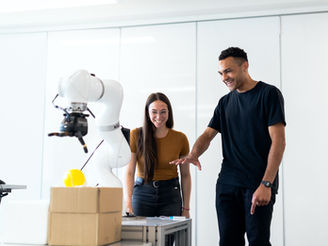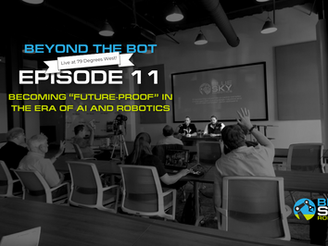top of page
Latest
Search


GPT-5 Ushers in a New Era for AI: What Businesses Should Know
The future of artificial intelligence is here, and it’s faster, smarter, and more integrated than ever. With OpenAI’s recent roadmap...
2 min read


GPT-5 Roadmap Revealed: What It Means for AI Users and Developers
OpenAI has once again made headlines in the artificial intelligence community. During a recent roadmap reveal, CEO Sam Altman shed light...
2 min read


How Helix Robots Learn: Training Methods Behind the Future of Humanoid AI
The intelligence of humanoid robots like Helix doesn’t come from the factory floor, it’s earned through thousands of hours of AI training and machine learning optimization. We explored how Helix was trained to see, understand, and act in human environments, and why its method represents a leap forward in robotic training efficiency.
2 min read


Inside the Mind of Helix: How Vision-Language-Action Models Power Smarter Humanoid Robots
Humanoid robots are evolving at a rapid pace, and at the heart of their progress lies one groundbreaking innovation: the...
2 min read


Figure 01's Helix Robot: Redefining Humanoid Robotics with Real AI Execution
Humanoid robots are no longer science fiction—they’re real, functional, and beginning to impact the future of work. Figure 01’s Helix...
2 min read


Smarter, More Human: What ChatGPT Update GPT-4.5 Means for Your Business
OpenAI’s latest model, ChatGPT 4.5, is here, and while it may not boast exponential leaps in raw reasoning power, it represents a major shift in how we interact with artificial intelligence. The emphasis? More human, intuitive, and emotionally intelligent conversations.
2 min read


Deep Research: Advanced AI Analysis
OpenAI’s new Deep Research feature represents a major step forward in practical AI use. Unlike standard web search that retrieves simple...
2 min read


AI in the Restaurant Industry
Rising labor costs, staffing shortages, and increasing customer expectations are reshaping the restaurant industry. Artificial intelligence and robotics are no longer futuristic novelties, they’re becoming essential tools for solving back-of-house inefficiencies and enhancing front-of-house experiences.
2 min read


Automation Isn’t Just About Speed—It’s About Precision
In modern manufacturing, consistency isn’t a luxury, it’s a necessity. When precision coatings or intricate fabrication are involved,...
2 min read


Reinventing Daily Operations with Cobot Capable Robots
Collaborative robots (cobot capable robots) are reshaping work across industries by blending flexibility, precision, and ease of use. No longer limited to simple tasks, modern cobots adapt to changing workflows, require minimal setup, and empower workers by reducing strain and increasing efficiency. As AI advances, these smart, user-friendly systems are becoming essential tools in creating smarter, more agile workplaces.
2 min read


Why Cobot Capable Robots Are the Future of Flexible Automation
Cobot capable robots are transforming the workplace by working safely alongside people—no cages, no complex programming. Lightweight, flexible, and AI-powered, these collaborative robots handle repetitive or delicate tasks with precision, making automation accessible to businesses of all sizes. From warehouses to labs, cobots enhance human productivity and enable smarter, safer workflows.
2 min read


How AI Is Revolutionizing Business Behind the Scenes
When most people picture artificial intelligence, they imagine robots on factory floors or drones in warehouses. But the real power of AI...
2 min read


Why AI Adoption Is Now a Business Imperative
AI is no longer just a buzzword, it’s a strategic necessity. From chatbots and machine learning to automation software and robotics,...
2 min read


Overcoming Barriers to Automation Adoption
Despite the clear benefits of automation, many organizations still hesitate to fully embrace it. Concerns around cost, disruption, and...
2 min read


The Real Impact of AI and Robotics on Job Roles
The rise of AI and robotics has triggered a lot of questions: Will machines take our jobs? Will humans be replaced? The truth is more...
2 min read


Future-Proofing your Business with Automation: Why “If It Ain’t Broke” Doesn’t Apply to Automation
In many manufacturing and industrial organizations, the phrase “If it ain’t broke, don’t fix it” still guides decision-making. But in a world defined by speed, scale, and innovation, that mindset may be holding businesses back, especially when it comes to automation. Automation isn’t just about solving problems, it’s about unlocking potential.
2 min read


Beyond the Bot Ep. 11 Live: Becoming “Future-Proof” in the Era of AI and Robotics
In this compelling episode of Beyond the Bot, hosts Tony DeHart and Steven King step away from the Blue Sky Lab and go live from 79 Degrees West. Their conversation, streamed across LinkedIn, YouTube, and beyond, dives deep into the evolving landscape of AI and automation in both physical and digital spaces.
5 min read


Debunking Common Automation Myths: Part 3
Manual systems often conceal high error rates and costly inefficiencies. Even a 1% data entry error rate can lead to recalls, defects, or lost revenue. In 2023 alone, labeling mistakes caused 50% of U.S. food and beverage recalls — with an average cost of $10 million per recall.
11 min read


Debunking Common Automation Myths: Part 2
Myth #10: Automating Ties You to a Single Vendor (Integrator Lock-In)
Reality: A common fear is that automation locks you into a single vendor forever. In truth, good automation partners empower you to be self-sufficient. They provide training, documentation, and even source code or schematics when needed. A responsible integrator treats the relationship as a partnership, ensuring your team can manage routine operations independently.
3 min read


Debunking Common Automation Myths: Part 1
Manual systems often conceal high error rates and costly inefficiencies. Even a 1% data entry error rate can lead to recalls, defects, or lost revenue. In 2023 alone, labeling mistakes caused 50% of U.S. food and beverage recalls — with an average cost of $10 million per recall.
4 min read
bottom of page






